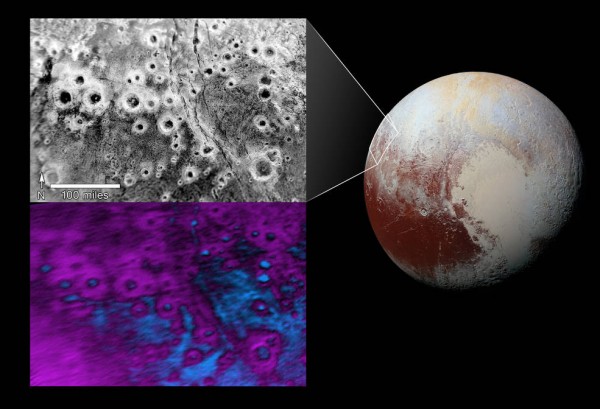By Ana Verayo, | April 24, 2016

Pluto's halo craters are made from methane ice rimming the edges and the walls.
New images of Pluto from NASA's New Horizons spacecraft has been released by the space agency, revealing icy "halos" on the surface of the dwarf planet that seem to shine in stark contrast on the darkest surface regions of Pluto.
Like Us on Facebook
These craters are observed to be scattered in a region known as Vega Terra as methane ice are seen on the ridges, rimming the craters and creating halo forms. NASA officials say that this bright methane ice often settle on these crater rims but the reason behind this is still a mystery, which is also not seen in other regions of Pluto.
The upper image reveals several dozen halos pockmarking the surface, taken last July during the historic flyby of Pluto. The bottom image reveals the largest crater halo that measures 30 miles wide but overall, all the halos on the craters appear glowing resulting from shining ice that accumulated over time.
Methane ice that are sticking on the walls and ridges of these craters is still a mystery to mission scientists but bright snow on Pluto is seen all over the icy dwarf planet.
Just last month, snowcapped mountain ranges were revealed in a series of images, appearing visible amidst the darkest regions of Pluto known as Cthulhu, that are composed of methane tholins. These bright mountain peaks could suggest snow on Pluto, scientists of the New Horizons mission team confirmed that this snow, could appear very different from snow on Earth.
Mission scientists say that this bright, glowing snow is made from mostly methane that has been condensed into ice crystals. On Earth however, methane is gas in form and is a common source of fuel but on the dwarf planet, methane appears in a different form due to frigid temperatures and its atmospheric conditions.
According to New Horizons mission scientist John Stansberry, this methane ice on Pluto can act like water on Earth's atmosphere but can condense as frost in higher altitudes. The methane ice snow in Cthulhu also appears similar to the ice halos on the crater ridges on Vega Terra says mission scientists.
These latest images are captured from a distance of 28,000 miles from the surface of Pluto by New Horizons' Long Range Reconnaissance Imager last July 2015.
-
Use of Coronavirus Pandemic Drones Raises Privacy Concerns: Drones Spread Fear, Local Officials Say

-
Coronavirus Hampers The Delivery Of Lockheed Martin F-35 Stealth Fighters For 2020

-
Instagram Speeds Up Plans to Add Account Memorialization Feature Due to COVID-19 Deaths

-
NASA: Perseverance Plans to Bring 'Mars Rock' to Earth in 2031

-
600 Dead And 3,000 In The Hospital as Iranians Believed Drinking High-Concentrations of Alcohol Can Cure The Coronavirus

-
600 Dead And 3,000 In The Hospital as Iranians Believed Drinking High-Concentrations of Alcohol Can Cure The Coronavirus

-
COVID-19: Doctors, Nurses Use Virtual Reality to Learn New Skills in Treating Coronavirus Patients







